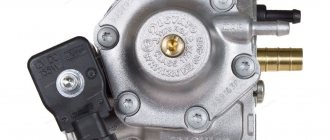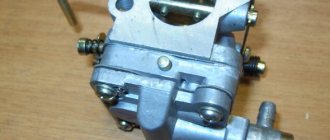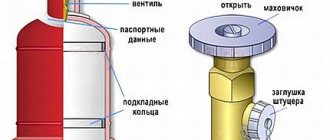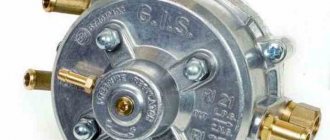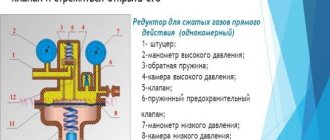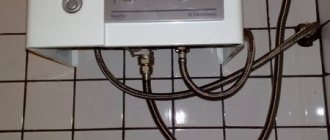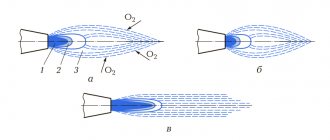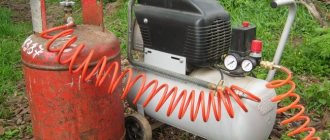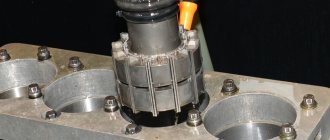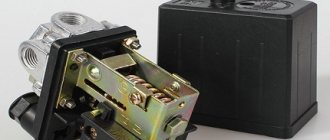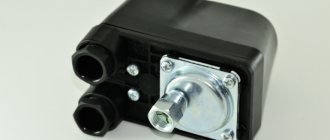After successfully installing a 2nd generation LPG on a car, and passing a test to ensure the functionality of its components and the absence of leaks of the propane-butane mixture (detected by “soaking” the connections or using a gas analyzer), the time comes for the need to adjust the equipment for further successful operation. The HBO adjustment is carried out sequentially in several steps, let's take a closer look.
Electronic gear adjustment procedure
An electronic gearbox, such as Tomasetto, provides for two main gas adjustments on carburetor cars:
- pressure in the second stage (it can be called sensitivity);
- the volume of gases passing through the channel at idle.
The engine must be started on gasoline fuel and warmed up to the nominal temperature level. The idle speed is set to one thousand per minute. The supply is turned off and gasoline is produced. The adjustments are in the following starting position:
- maximum eversion of the dispenser (the gas channel is open to the largest cross-sectional area; with a two-section chamber, each chamber is adjusted separately: for the first - the largest opening, for the second - the minimum);
- the screw that determines the idle speed is screwed to the extreme position and unscrewed five turns;
- the screw adjusting the sensitivity is installed in an intermediate position.
First you need to set the idle speed. To do this, the car starts on gas fuel, using a choke, the speed is set to two thousand per minute. Then the choke is gradually removed, and by rotating the screw that determines the idle speed, the speed is set to the maximum. These operations are repeated until the choke is completely removed and the engine operates stable in idle mode.
The maximum speed is set using the idle speed screw. The screw that determines the sensitivity is gradually tightened. When the speed is lost, they are added by the screw that regulates the idle speed. If this does not work, then the sensitivity adjustment is tightened a couple of turns and the procedure is repeated.
At the end of the adjustment, this screw will be screwed in almost all the way, and the engine speed when idling reaches its maximum value - about 1.2 thousand per minute. After this, this indicator is reduced - slightly below the nominal value, by tightening the idle speed screw, then, unscrewing it slightly, it is set to about a thousand revolutions per minute.
Next, you need to adjust the sensitivity of this unit: the adjustment of the same name is gradually turned away until it affects the engine speed when idling, and it is twisted approximately one turn in the opposite direction. If everything is done correctly, when you press the gas pedal sharply, the power plant should respond responsively.
You might be interested >> Repair of gas equipment
The third step is to set up the dispenser. With the engine running, the revolutions are set to three and a half thousand per minute, and the screw of the mechanical gas dispenser is tightened until they begin to change. Then this adjustment must be turned back half to three-quarters of a turn.
For a two-section dispenser that provides for separate settings in sections, the above applies to the first of them, the second is placed at a third of the previously configured ones.
If the pressure in your reducer is adjusted in the first stage, then turn off the motor and close the gas flow pipe. Then, using the control hole, which is closed with a bolt, connect a pressure gauge to the cavity of the first stage, allowing you to measure pressure up to one and a half kgf/cm2.
The power plant starts up, and at idle the pressure level is set to about 0.4 kgf/cm2. Then the idle speed and sensitivity of the gearbox are adjusted again. You should take into account the increased gas hazard of these works, therefore, if you are not confident in the reliability of the connection, you need to contact a service center.
Attention! Work on adjusting the two-section dispenser poses an increased gas hazard. Be careful.
Which system should you choose?
There are several leading LPG manufacturers in the world, one of which is Lovato. The equipment has a fairly high build quality, as well as high performance indicators. A particular advantage is the electronic control unit, which calculates all readings with excellent accuracy and very rarely fails. You can also note the compactness of this installation, in comparison, for example, with BRC equipment. It is worth choosing LPG for a specific type of gas, that is, either for liquefied propane or for compressed compressed methane. By the way, when using propane, gasoline injectors can be used, since the density and consistency of the gas is close to gasoline. When working with compressed gas, it is necessary to use special gas injectors.
Setting up the vacuum reducer
There are two types of vacuum reducers:
- providing separate adjustment at idle speed, as well as sensitivity;
- having a combined regulator of these two settings.
In the first case, the adjustment is carried out similarly to the adjustment of the electronic gear described above. If the regulator is combined, as in the 2nd generation Lovato LPG for cars with a carburetor, the adjustment is as follows:
- the car starts using gas, the speed is adjusted by suction, up to two thousand per minute;
- the choke is gradually removed, the speed is set to maximum by tightening the screw that adjusts the idle speed;
- The same adjustment adjusts the number of revolutions, about a thousand per minute or a little more;
- With a similar setting, the speed is further reduced below the nominal value, and then again rises to a thousand per minute.
This is how the 2nd generation Lovato LPG is configured for the carburetor.
Is it worth installing HBO on your car?
Installing HBO on your car is a completely individual matter, but still, such a decision is justified.
Gas is much cheaper than conventional fuel and this is already one of the reasons to switch to it. The second is, of course, environmental friendliness.
The gas burns almost completely, leaving behind no harmful emissions or toxic substances, and significantly less carbon deposits are formed. Gaseous fuel does not harm the engine at all and does not cause frequent breakdowns, and most problems associated with valves and pistons are rather a problem of saving on fuel and maintenance. The only disadvantage of HBO is that it requires constant and timely adjustment, especially at the beginning of a new season.
Adjusting the dispenser
The final step is setting up the dispenser. To do this, you need to start the car on gas fuel and set the speed to about three thousand per minute. There is no need to use suction, it is better to involve a partner. Then the screw that regulates the dispenser is tightened until the speed begins to change.
You need to fully verify the presence of this boundary by playing with the screw in one direction or the other. From this threshold, the adjusting screw is unscrewed by half to three-quarters of a turn. After a slight adjustment of the idle speed, the gas injection system for the carburetor can be considered configured.
You might be interested in >> Adjusting the 2nd generation Tomasetto LPG gearbox
It is also recommended to check the correct settings of gas equipment for a carburetor engine based on the concentration of oxygen and carbon monoxide in the exhaust. The CO level should not exceed 0.45%. Adjustment is carried out using screws that supply air to the carburetor and regulate the idle speed of the gearbox. If the indicator is underestimated, you need to add it to the second of the specified settings; in the opposite situation, vice versa.
Checking the oxygen content in domestic conditions poses a certain problem. To do this, configure the HBO as follows:
- an oxygen sensor intended for injection modifications of the Lada is installed in the muffler behind the “pants”, this is done using a pre-welded adapter nut;
- contacts for heating are connected in the same way as a gas valve; for signaling, a shielded wire is used, connected to the dashboard and connected to the tester.
As a result, HBO adjustment occurs under your constant control. If the tester shows a voltage level of 0.2-0.8 V, then everything is normal, a lower level means there is not enough oxygen, a higher level means there is too much oxygen. However, depending on the load and operating mode of the engine, these parameters may change, so fine tuning is still necessary.
Note! The ability to adjust the oxygen level is achieved only after installing additional equipment.
An even more interesting option is to use a lambda probe emulator, which provides the possibility of color indication. Three LEDs, similar to a traffic light, indicate optimal operation. A microprocessor unit can be connected to this device, which allows you to control the adjustment of the electronic dispenser, but such work cannot be handled independently, and you need to contact a service station. Moreover, this pleasure is not cheap.
What is gas equipment
HBO is gas-cylinder equipment. It is a gas installation that powers the engine instead of conventional fuel. Gas can be of two types - propane or methane. In practice, they differ little (except for the state of aggregation), but in terms of price and storage they still have slight differences.
LPG for a passenger car
There are several types of HBO:
- First;
- Second;
- Third;
- Fourth;
- Fifth generation.
The higher the generation, the more advanced the system (more sensors and electronics are used, everything is calculated more accurately and the operating efficiency is higher). But the generation of HBO is selected depending on the type of engine and it is not always possible to use the 5th generation installation on an old engine.
Injector with gas equipment
Gas is supplied to the injection engine through the air manifold. The injector runs on gas, the injectors and the fuel pump are turned off, only the gas damper, spark and knock sensor work. Therefore, if the injector works well on gasoline, but poorly on gas, diagnostics will not help (everything is fine with the injector), adjust the gas reducer.
There are injectors with installed gas injectors, these injectors are connected to a control unit (computer), but I think there is little point in installing such injectors on purpose, since it is expensive and you cannot set them up manually.
Another good thing about gas on an injector, I saw an injection car with dead injection equipment, there wasn’t even a gas pump in the tank. But on gas it worked perfectly; when running on gas, it was enough for this engine to have a spark and the gas damper control sensors worked during warm-up.
Advantages and disadvantages of HBO 2
Despite some imperfections, 2nd generation gas equipment has its advantages:
suitable for engines with fuel injection and for cars with carburetors; the design of second-generation gas equipment is simple and reliable; easy connection diagram and installation of gas equipment; it is easy to configure and regulate the system; An important advantage is that you can regularly start the engine on gas at an ambient temperature above 10 degrees Celsius.
The advantages of second-generation gas equipment include the low cost of repair kits.
Flaws:
- There is no feedback from the car engine, which leads to unstable operation in some modes (motor elements fail prematurely due to incorrect settings for the mixture quality or ignition timing).
- Increased gas consumption.
- There is a danger of a backfire of the gas mixture in the intake manifold.
- The emission of spent fuel in 2nd generation gas equipment does not comply with Euro-3 standards and higher.
- Slow response to pressing the accelerator pedal.
- The need to constantly adjust the valve clearance to prevent uneven engine operation under heavy loads.
When operating HBO 2, it should be borne in mind that water entering the air intake affects the number of revolutions.
You can’t do business with the 2nd generation of gas equipment today, since new versions of gas equipment have been released, which take into account many of the shortcomings.
Starting a car engine with HBO in winter
In winter, in severe frosts, it can be difficult to start a car even on gasoline, but on gas it becomes a problem. After all, the coolant in the engine is cold and it is simply not possible to warm the gearbox. In this case, the engine is started on gasoline. To do this, during installation, an electromagnetic valve is installed on the gas line; it operates only when the ignition is turned on.
To switch the engine from gasoline to gas, a three-position button is installed in the car interior, which has three operating positions “petrol - neutral - gas”.
- In the first position, gasoline is supplied, the gas is turned off.
- In the second position, both gas and gasoline are turned off.
- In the third position, the gas supply is turned on and gasoline is turned off.
This combination is needed to manage the transition from gasoline to gas. When the engine is started on gasoline and it has warmed up, the switch is switched to the “neutral” position, at this time the gasoline remaining in the carburetor burns out and only after that is switched to the “gas” position.
